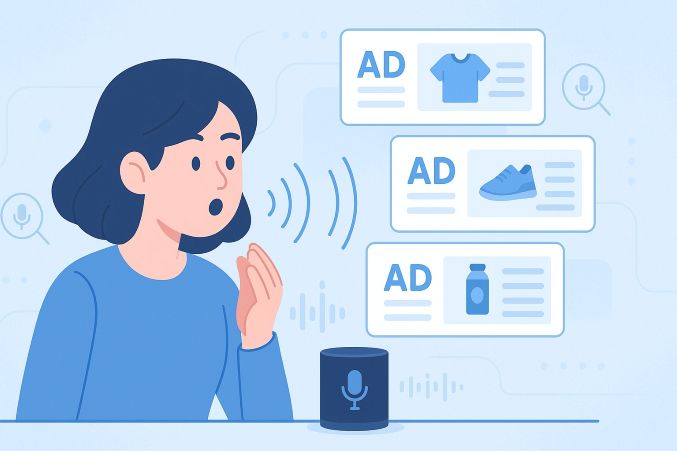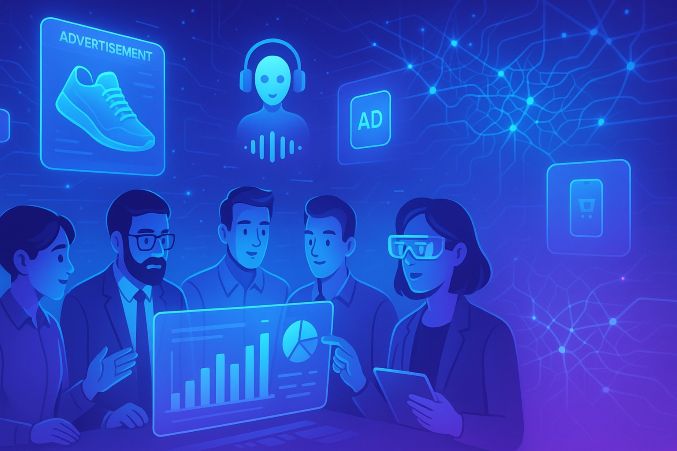The Future of Paid Advertising: Voice Search, AR, and Predictive Targeting
The digital advertising space is changing faster than ever before, fueled by swift innovation in artificial intelligence (AI), augmented reality (AR), and voice recognition technologies. As we march further into 2025, advertisers have to keep up with these transformations or fall behind.
We'll discuss the first five major areas that are defining the future of paid advertising in this blog.
- Introduction: Navigating the Next Frontier of Paid Advertising
- Voice Search Revolution: Optimizing Ads for Conversational Queries
- Augmented Reality in Advertising: Creating Immersive Brand Experiences
- Predictive Targeting: Leveraging AI for Proactive Ad Campaigns
- Integrating Voice, AR, and Predictive Analytics: A Holistic Approach
Let's get started.
1. Introduction: Navigating the Next Frontier of Paid Advertising
The ad business is experiencing a seismic change. PPC (Pay-Per-Click) and display ads no longer cut it to get consumers' attention in today's increasingly digital-first world. Rather, three significant innovations are taking the reins:
• Voice Search – As smart speakers and voice assistants become everywhere, brands have to optimize for natural, conversational searches.
• Augmented Reality (AR) – AR ads enable consumers to experience products virtually, unifying online and offline worlds.
• Predictive Targeting – AI-driven algorithms scan enormous datasets to forecast consumer actions, allowing ultra-personalized ad placement.
These are not trends—they are reshaping brand interaction with audiences. Businesses that adopt them early will reap a major competitive benefit.

2. Voice Search Revolution: Preparing Ads for Conversational Queries
The Age of Voice Search
By 2025, there will be more than 75% of U.S. households owning a smart speaker (e.g., Amazon Echo, Google Nest). Voice search is no longer new—it's a mainstream means of searching for information.
Voice queries differ from typed queries in that they are:
• Longer and more chatty (e.g., "Hey Google, where can I get organic coffee beans around me?" rather than "organic coffee beans").
• Local-intent dominant (users tend to request local stores or services).
• Action-oriented (users use voice search to make instant decisions).
How Advertisers Need to Adapt
In order to thrive in voice search advertising, brands need to:
✔ Optimize for Natural Language Processing (NLP) – Employ long-tail, question-based keywords (e.g., "best running shoes for flat feet").
✔ Take advantage of Local SEO – Make sure business listings are up-to-date on Google My Business, Yelp, and other directories.
✔ Make Voice-Friendly Content – Produce FAQ-type content that provides answers to popular voice questions.
✔ Use Voice Ads – Amazon Alexa and Google Assistant now have voice-sponsored ads where brands can bid for the top response.
Example: Customers can order from Domino's Pizza using Alexa by simply saying, "Alexa, ask Domino's to order my usual." The hassle-free integration increases conversions.
3. Augmented Reality in Advertising: Building Immersive Brand Experiences
Why AR is a Game-Changer for Ads
Augmented Reality (AR) brings digital information on top of the real world, enabling interactive ad experiences. By 2025, the AR advertising market will reach over $12 billion, fueled by:
• Virtual Try-Ons (e.g., Sephora's AR makeup trials).
• Interactive Product Demos (e.g., IKEA's AR furniture placement tool).
• Gamified Ads (e.g., Pokémon GO's sponsored locations).
Benefits of AR Advertising
✅ Increased Engagement – Users spend 4 times longer engaging with AR ads compared to static ones.
✅ Better Conversions – Brands such as Gucci show 30% increased sales when using AR try-ons.
✅ Improved Personalization – AR ads adjust in real-time according to user interactions.
Implementing AR Ads
• Social Media AR Filters (Snapchat, Instagram, TikTok).
• Web-Based AR (No app download needed—users access AR through browser).
• QR Code Triggers (Scan a code to unlock an AR experience).
Example: Nike's SNKRS app leverages AR to enable users to "unlock" special sneaker releases by scanning their phone at real-world locations.

4. Predictive Targeting: Using AI for Preemptive Ad Campaigns
What is Predictive Targeting?
Predictive targeting employs machine learning to study past consumer behavior and forecast future actions. This enables advertisers to:
• Serve ads to users before they even search for a product.
• Real-time bid adjustments according to probability of conversion.
• Dynamically personalize messaging.
How AI Drives Predictive Ads
• Behavioral Data Analysis – Monitor clicks, browsing history, and purchase behavior.
• Lookalike Audience Modeling – Identifies new customers like high-value existing ones.
• Real-Time Bidding (RTB) Optimization – AI real-time spends ad for best ROI.
Example: Netflix utilizes predictive algorithms to suggest shows, lowering churn and improving watch time.
5. Integrating Voice, AR, and Predictive Analytics: A Holistic Approach
The future of advertising lies in combining these technologies for a seamless user experience.
Example Scenario:
- A user asks their smart speaker, "What's the best skincare routine for dry skin?"
- The brand (e.g., Olly Nutrition) responds with a voice ad and follows up with an AR filter letting users "try on" different skincare products.
- Predictive AI subsequently retargets the customer with a personalized discount through email or social media.
Key Takeaways for Advertisers
✔ Integrate voice, AR, and AI for multi-touchpoint campaigns.
✔ Leverage data in one channel to optimize another.
✔ Test and iterate—new tech demands ongoing experimentation.

6. Case Studies: How Top Brands Are Crushing It with Next-Gen Advertising
A. Coca-Cola's Voice-Activated Vending Machines: A Masterclass in Conversational Commerce
Strategy Deep Dive:
• Partnered with Amazon to integrate Alexa Voice Service into vending machine hardware directly
• Created own "Thirst Detection Algorithm" analyzing:
o Local weather information (more cold drink suggestions in summer)
o Time of day (caffeine recommendations in mornings)
o Purchase history (favorite recognition)
• Applied dynamic pricing where voice ordering could unlock special deals
Expanded Results:
✅ 27% boost in first-time user adoption within 3 months
✅ 15% higher average order value due to voice interactions compared to touchscreen
✅ Shortened perceived wait time by 40% with chatty interaction
Behind-the-Scenes Tech:
• Hand-tuned natural language understanding (NLU) models trained on 50,000+ drink-related search queries
• Real-time integration with stock systems to only recommend available items
B. Sephora's AR Virtual Artist: Disrupting Beauty E-Commerce
Improved Strategy Breakdown:
• Built 3D facial mapping tech with 20,000+ facial reference points
• Developed shade-matching AI matching user skin tone to 15,000+ product SKUs
• Introduced social sharing functionality allowing users to poll friends on makeup looks
Deeper Performance Metrics:
✅ 53% reduction in product returns due to improved color match
✅ 28% increase in average session time compared to regular product pages
✅ Created 2.3 million user-generated content items within first year
Technical Innovations:
• Proprietary light-compensation algorithms dealing with subpar lighting situations
• Texture simulation engine demonstrating how products would appear across various skin types
C. Netflix's Predictive Content Engine: The Science Behind Your Addiction
Advanced Tactics:
• Implemented multi-modal AI systems inspecting:
o Visual tastes (color palettes, shot composition)
o Taste patterns (music preferences, speech pacing)
o Micro-behavioral signs (when viewers lean forward/check phones)
• Established "Clone Taste Profiles" enabling users to follow recommendations of similar viewers
Wider Impact:
✅ 22% increase in content discovery satisfaction ratings
✅ 18% decrease in marketing expenditure through improved targeting
✅ Generated 3 new hit programs based solely on predictive viewership analysis
System Architecture:
• Petabyte-scale database for user behavior
• Real-time rendering of individualized trailer versions
7. Challenges and Considerations: The Hidden Obstacles in Next-Gen Advertising
A. Privacy Concerns & Data Regulations: Navigating the Minefield
Emerging Challenges:
• Differential privacy requirements forcing data anonymization
• Cross-border data flow restrictions complicating global campaigns
• AI explainability mandates requiring transparency in targeting decisions
Cutting-Edge Solutions:
• Federated learning keeping user data on-device
• Blockchain-based consent management systems
• Synthetic data generation for algorithm training
B. The True Cost of Innovation: Budgeting for the Future
Hidden Expenses:
• Talent acquisition for AR developers (salaries up 35% since 2023)
• Cloud computing costs for real-time AI processing
• Maintenance of sophisticated systems over time
Cost-Optimization Strategies:
• AR-as-a-service solutions shortening development time
• Pruning of predictive models to lower compute needs
• Voice search co-op initiatives with hardware providers
C. Closing the Adoption Gap: Early Adopters to the Masses
User Education Strategies:
• In-store AR kiosks staffed by ambassadors
• Voice search literacy efforts
• Generational targeting (separate strategy for Gen Z and Boomers)
D. When Technology Breaks: Anticipating the Unavoidable
Shared Failure Points:
• Voice recognition failures in noisy settings
• AR tracking failures with dynamic subjects
• Prediction model drift over time
Contingency Plans:
• Multi-modal fallbacks (voice + touch interfaces)
• Offline-capable AR experiences
• Continuous model monitoring systems
8. Future Outlook: Beyond 2025 - The Advertising Revolution Continues
A. Metaverse Advertising: Building Brand Universes
Coming Innovations:
• Digital twin integration connecting physical products to virtual assets
• Wearable ad tech such as smart glasses with onboard promotions
• Tokenized advertising with NFTs for premium experiences
B. The AI Content Revolution
Emerging Capabilities:
• Emotionally adaptive copywriting modulating tone in real-time
• Video synthesis generating personalized commercial variants
• Generative product design from forecasted trends
C. Neuro-Marketing 2.0: Reading Consumers' Minds
Breakthrough Technologies:
• Integration of EEG headset measuring ad engagement
• Pupil dilation tracking for detecting subconscious interest
• Haptic feedback ads stimulating physical responses

9. Actionable Steps: Your Roadmap to Advertising's Future
Step 1: Voice Search Optimization - Beyond the Basics
• Apply schema markup for voice with SpeakableJSON-LD
• Design voice search funnels with sequentially progressive question flows
• Build brand sonic logos for audio identification
Step 2: AR Advertising - From Novelty to Necessity
• Implement WebAR experiences with no app download needed
• Develop AR-enabled packaging with instant activation
• Create location-based AR for physical retail environments
Step 3: Predictive Targeting - Advanced Implementation
• Deploy churn forecasting models for customer retention campaigns
• Implement sentiment-based bidding from real-time mood analysis
• Utilize dynamic creative optimization at scale
Step 4: Measurement - The New KPIs
• Track emotional engagement scores
• Measure conversation depth in voice interactions
• Analyze AR interaction heatmaps
10. Conclusion: The Advertising Renaissance
We're on the cusp of the biggest shift in advertising history. The intersection of voice interfaces, augmented reality, and predictive AI isn't merely rewriting the way we advertise—it's remaking the very nature of the brand-consumer relationship.
The champions in this next phase will be those who:
• Perceive technology as an experience driver, rather than a distribution mechanism
• Develop adaptive systems that adapt to consumer behavior
• Preserve ethical roots while extending creative limits
The answer is not if your brand will be using these technologies, but when you can get to mastery. The future will be owned by the fearless, the inquisitive, and the continuously innovative.
Your Next Steps:
- Audit your best products with voice search
- Create one AR experience in the next 30 days
- Find one predictive model to deploy this quarter
The advertising revolution won't wait. Will you lead it or follow it? The choice—and the opportunity—is yours.


Comments
No Comments To Display